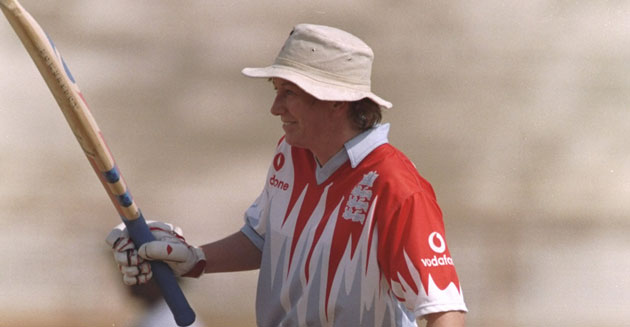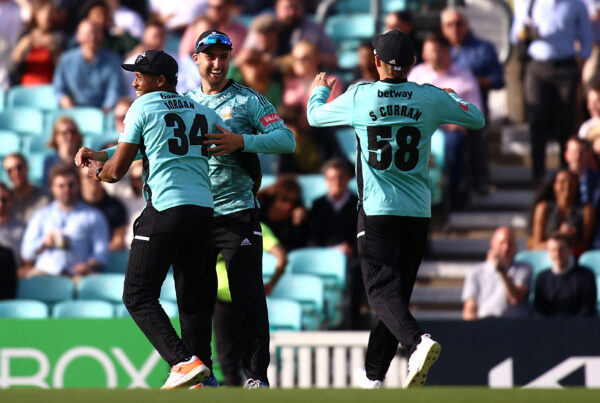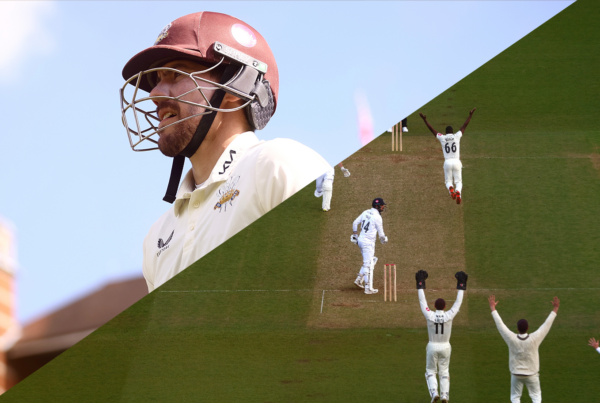On International Women’s Day 2022, we go back to a 2019 piece from journalist Raf Nicholson profiling ICC Hall of Famer Jan Brittin.
Janette Ann Brittin was one of women’s cricket’s brightest stars until her untimely death from cancer in September 2017.
She grew up in Chessington, Surrey, and represented the county between 1977 and 1998. More recently she served as a coach to young Surrey players, passing on some of the wisdom acquired in her 19-year international career. She was awarded the MBE in 1999 for services to cricket.
Born in Kingston-upon-Thames in 1959, she attended Fleetwood County Secondary School (now Chessington Community College). She was a naturally talented sportswoman from a young age, representing English schools at athletics; she eventually achieved the rare feat of becoming a triple international, adding indoor hockey and indoor cricket to her mantle.
Cricket came relatively late in the day: at 12 years old her grandparents took her to a Steam Engine Fair, where she was attracted to a catching machine.
Her catching skills were such that she was recruited on the spot for a local club, Tadworth, by the lady operating the machine. Her county debut and Junior England soon followed. Her first international appearance came at home against West Indies in 1979, aged 19.
Asked once about the greatest influence on her career, Brittin replied: “my family – for their love and support and financial backing”. Her father, Kevin, helped to instil in her a love of sport: he had played junior football for Spurs, and was later a part-time professional at Reading, as well as a keen club cricketer.
Her parents ran a sports shop in Surbiton, where Jan sometimes helped out. But as an only child it was the practical support her parents offered that was most crucial. “That helps a lot when, for the privilege of playing for England in a Test match in this country, you have to pay for your own petrol to get there,” she remarked wryly, in a 1984 interview for the Daily Mail.
Playing as an amateur for the whole of her career, at a time when there was very little money at any level of the women’s game, and when every pound of sponsorship had to be fought for, Brittin juggled cricket with firstly her studies at Chelsea PE College, and then with her work as a teacher at Wallington County Grammar School and as a manager for British Airways.
There was very little media coverage of women’s cricket in the 1980s, but Brittin’s talent was nonetheless an irresistible draw. The breakthrough came over the winter of 1982/3, a season she spent playing in Western Australia. England Men had surrendered the Ashes, but Brittin returned home in February with a season batting average of 110. A classical batsman, she was from that point on termed “the girl with a touch of Gooch”, a label she happily accepted.
When her photograph appeared on the front cover of The Cricketer in October 1984 she became the first female player to be awarded such prominence; when Kwik Cricket was launched in January 1988 as a response to the near death of cricket within state schools during the 1980s, the launch was attended not only by Mike Gatting but by Brittin – by then very much England Women’s premier batsman of the day.
Despite the fame she remained a quiet and self-effacing person, happy to let her batting do the talking. And talk it did. Her debut Test century came against New Zealand in 1984, followed up with scores in the next two Tests of 96, 63 and 35.
She was, unsurprisingly, chosen as Player of the Series. Four more Test hundreds would follow – her highest score coming in 1998, in the penultimate match of her career, as she hit 167 against the Aussies. The runs just never dried up.
Her consistency saw her promoted to the England vice-captaincy ahead of the 1988 World Cup in Australia. Her career highlight, though, was undoubtedly England’s World Cup win at home in 1993. It was during that tournament that she became England’s leading run-scorer, adding two more centuries to her ODI tally, against Denmark and India.
More importantly, as far as she was concerned, were her 48 runs in the final at Lord’s against the Kiwis. Fittingly it was Brittin who took the winning catch, out on the hallowed turf. “It was,” she said later, “the stuff of dreams.”
During her career Brittin witnessed a period of great change for the women’s game, epitomised by the shift from skirts to trousers at the start of her penultimate series in England, against South Africa in 1997. Brittin herself was at the forefront of that shift. Always an athletic fielder, renowned for her dives at cover – she retains the record for most World Cup catches, with 19 to her name – it was her sliding stops and badly grazed legs which helped to convince the cricketing sorority that skirts were no longer suitable for international cricket.
Injury afflicted her twice towards the end of her career: struck in the eye while batting over the winter of 1995/96, she underwent surgery to repair the damage, but was nonetheless back to face New Zealand by the 1996 summer.
Two years later she spent much of her final Test series, at home against Australia in 1998, batting with a broken finger. It did not seem to affect her in the least: she finished the 3-Test series with two centuries and an average of 112.5.
Never one to wallow in plaudits, she was happy to remain largely out of the spotlight after her retirement from cricket in 1998, aged 39. Nonetheless her place in the record books is secure: across 27 Tests between 1979 and 1998 she averaged 49.61, scored five centuries, and took 9 wickets with her part-time off-spin. No one has yet surpassed her record of 1,935 Test runs: no one is ever likely to.









